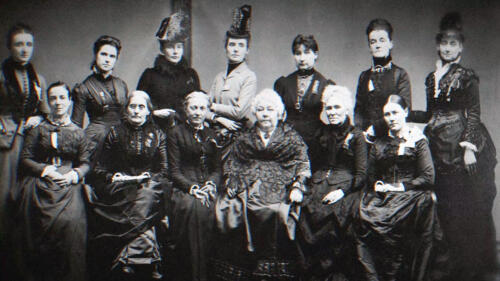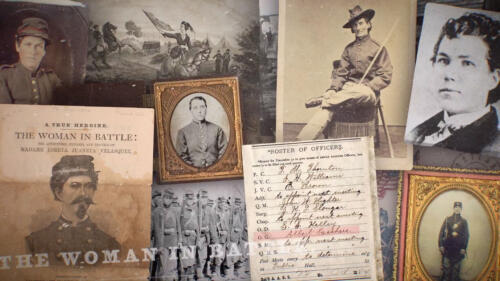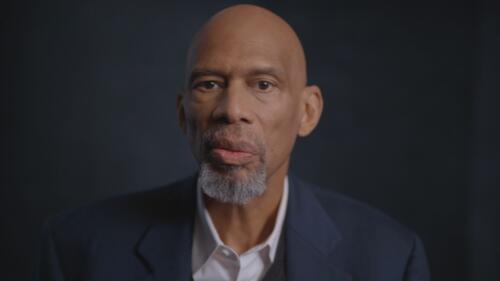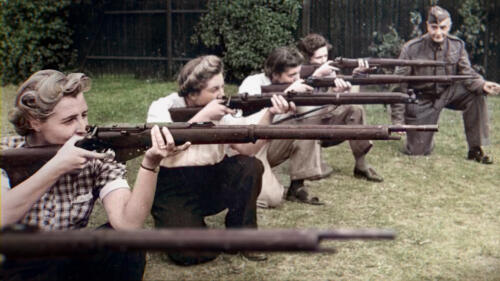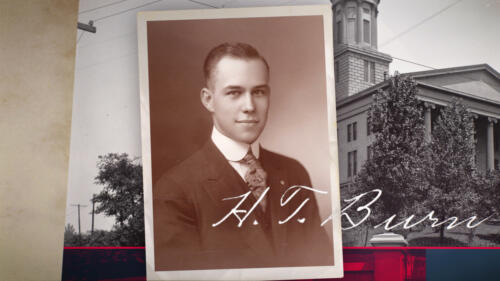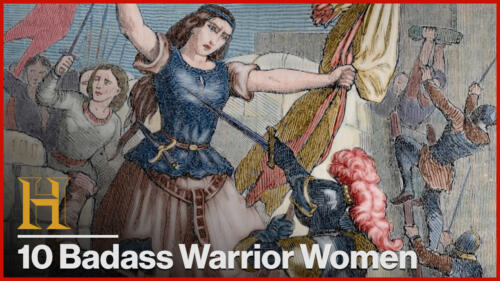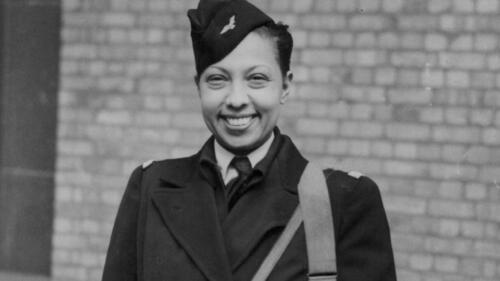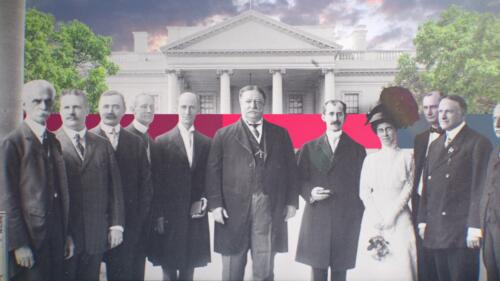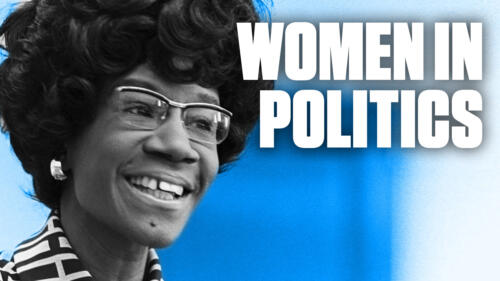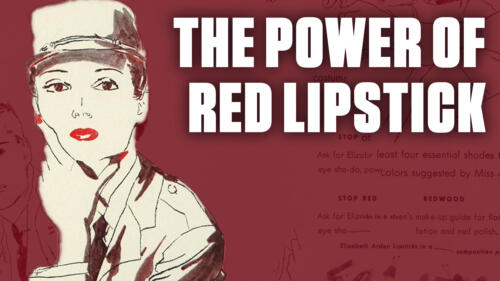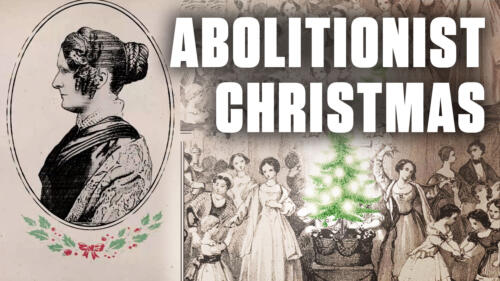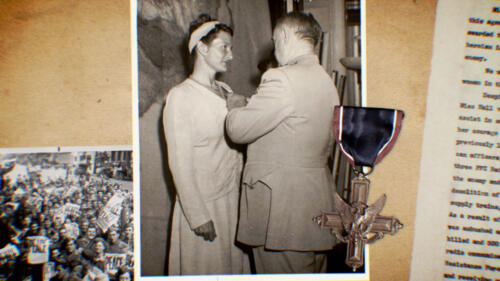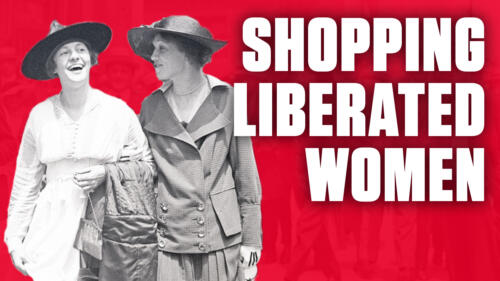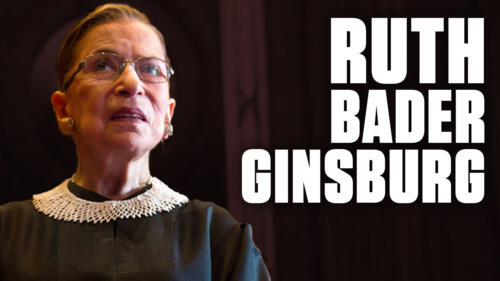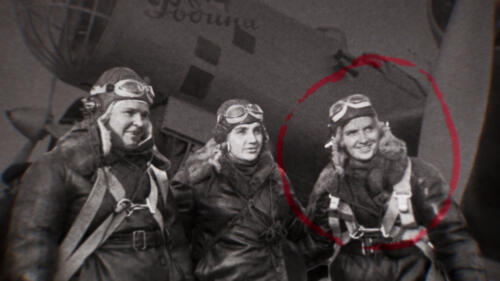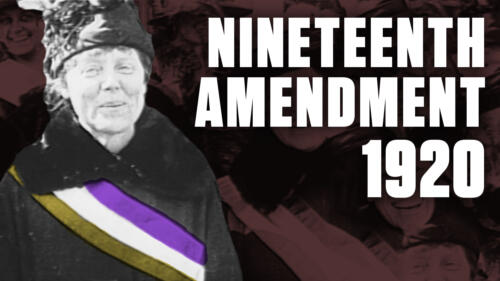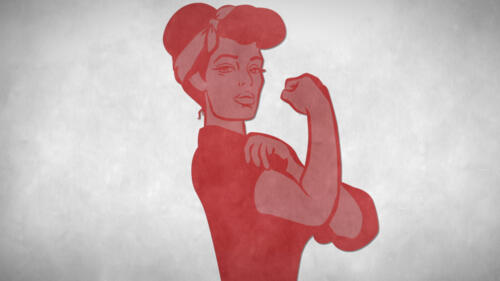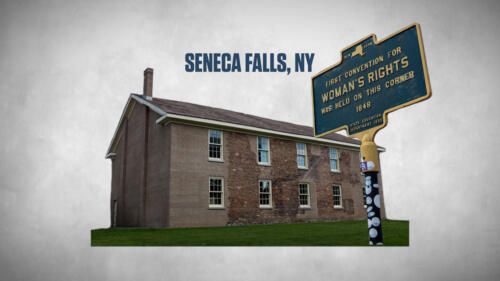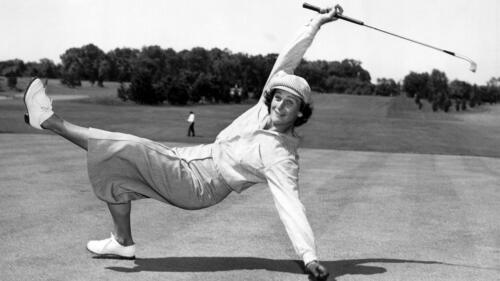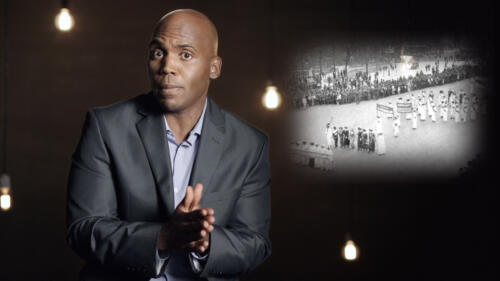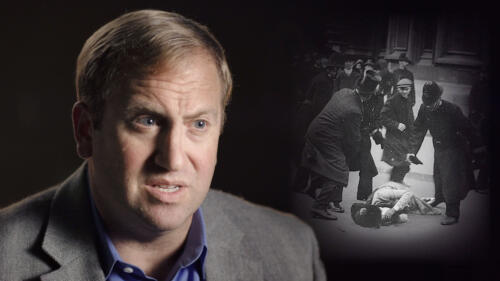Women’s History
From raising families to leading armies, women such as Catherine the Great, Eleanor of Aquitaine, Queen Amanirenas, Queen Elizabeth I, Susan B. Anthony, Rosa Parks, Marie Curie, Rosalind Franklin and countless others have played a vital role in history.
Featured Overview
Discover five extraordinary women whose leadership and determination redefined America —proving that change happens when bold voices rise.
9:51m watch

Illustration by Eduardo Ramón Trejo. Photos from Getty Images.
Featured Overview
Discover five extraordinary women whose leadership and determination redefined America —proving that change happens when bold voices rise.
9:51m watch
Start Here

From a plea to a founding father, to the suffragists to Title IX, to the first female political figures, women have blazed a steady trail towards equality in the United States.

The history of established feminist movements in the United States roughly breaks down into four different time periods.

Despite the adoption of the 19th Amendment, many women of color, immigrant women and poorer women continued to face barriers at the polls.

They scored historic victories in their respective countries and left lasting legacies.

3 Women Who Ruled the Ancient World
Women Take to the Skies During WWII
More to History: Women Take to the Skies During WWII
In America's forgotten war, one hero with heritage on the other side of the battlefield put himself in harm's way to save his fellow soldiers.
1:02 watch
Explore All Related Topics

Women have been held to ever-shifting, often extreme standards of beauty for centuries. But some have taken matters into their own (well-groomed) hands.

While male business titans dominated in the late 1800s, these women also made their mark, from opening their own banks to amassing millions on Wall Street.
Discover five extraordinary women whose leadership and determination redefined America —proving that change happens when bold voices rise.
9:51m watch
Researchers at the National Archives have found evidence that at least 250 women dressed as men to fight in the Civil War, some motivated by ideology, some by a taste for adventure and some by the need for a job.
1:00m watch
Elizabeth Freeman's story is nothing short of incredible—her ability to win freedom in Massachusetts' courts prompted future legislation for abolition.
4:43m watch

Belva Lockwood not only ran for president—twice—she was also the first female lawyer to argue a case before the U.S. Supreme Court.
Kareem Abdul-Jabbar talks about Women's Rights past and present.
2:14m watch

Esther Eggertsen Peterson was a driving force behind the Equal Pay Act of 1963, and also pushed for better child care resources.
In America's forgotten war, one hero with heritage on the other side of the battlefield put himself in harm's way to save his fellow soldiers.
1:02m watch

Carrie Chapman Catt fought for equal voting rights as president of the National American Woman Suffrage Association and founder of the League of Women Voters.

Long before Martha and Oprah, as far back as the late colonial era, these successful business women were breaking glass ceilings.

Since the early 1800s, U.S. federal and state governments have taken steps both securing and limiting access to contraception and abortion.

The U.S. Supreme Court's 1992 ruling in Planned Parenthood of Southeastern Pennsylvania v. Casey reaffirmed a woman's right to an abortion as granted in the 1973 Roe v. Wade case. However, the decision altered Roe and upheld a number of abortion requirements cited in the case, while broadening the authority of states to regulate and restrict abortions. Planned Parenthood v. Casey was overturned in 2022.

Mary Tornich Janislawski guided World War II pilots and astronauts in how to use celestial bodies for navigation.

The history of established feminist movements in the United States roughly breaks down into four different time periods.

In 1861, Kate Warne kept the president-elect safe from an assassination plot on his train journey to Washington.

From a Viking 'far traveler' to a Soviet cosmonaut, these fearless women blazed daring new trails.
In 1968 Shirley Chisholm became the first Black woman elected to Congress, and in 1972 she was the first Black major party candidate to run for president. But beyond being a first, who was Shirley Chisholm? And how does her legacy impact us all today?
6:54m watch
Sometimes, it really does come down to one vote (and the voter's mother) to change history.
1:04m watch
From Tomoe Gozen to Jeanne Hachette, these 10 badass warrior women have slashed their way into the history books, in this episode of History Countdown.
10:38m watch
These 6 women were true triple threats: performers, celebrities - and spies! From Julia Child to Audrey Hepburn, these are 6 famous women who were secretly spies, in this episode of History Countdown.
8:41m watch

A combination of cultural shifts and metal rationing spelled the demise of the stiff undergarment.

Women infused their protests with creativity, PR savvy and in-your-face urgency.

Doctors of the Women's Oversea Hospitals Unit operated under bomb and gas attacks. And their all-female support teams built new hospitals—even the coffins.

Despite the adoption of the 19th Amendment, many women of color, immigrant women and poorer women continued to face barriers at the polls.

Women inventors are behind a wide range of key innovations, from Kevlar to dishwashers to better life rafts.

Carrie B. Shelton had the power to veto bills as Oregon governor—but she couldn’t vote.

From Seneca Falls to the civil rights movement, see what events led to the ratification of the 19th amendment and later acts supporting Black and Native American women's right to vote.
Elizabeth Blackwell was the first woman in America to earn a medical degree, and used her talents to support Union troops on the frontlines of the Civil War. But she was never given the credit she deserved.
1:00m watch

The 19th Amendment was ratified just in time to include women voters in the presidential election.
Without their sister, Katharine, the Wright brothers may have never taken flight.
1:00m watch

The ERA was on track to become the 27th amendment to the U.S. Constitution. Then a grassroots conservative movement halted its momentum.

They scored historic victories in their respective countries and left lasting legacies.

Women working while pregnant in the United States have faced shifting rules and protections through the decades.
Growing up in the Bronx, Sonia Sotomayor was a die-hard Yankees fan. Little did she know she would one day help save the sport itself.
1:02m watch

World War I helped women around the world get the vote.
American history author David McCullough shines a light on Emily Roebling, the true driving force behind the construction of the Brooklyn Bridge.
1:02m watch

Under the 'American Plan,' women could be detained for sitting in a restaurant alone, changing jobs—or, often, for no reason at all.
Brenda Berkman is the reason women are allowed to join the New York City fire department-- this is the story of her fight.
5:19m watch
From historical figures like Jeannette Rankin, the first woman in Congress, to modern ones like Tammy Duckworth, the first disabled person in Congress, meet 5 women who have paved the way for others in politics.
2:50m watch
Robin Morgan led the protest of the 1968 Miss America Pageant by the New York Radical Women. This event brought feminism to the forefront and left an imprint on protest movements that followed.
2:36m watch
A group called The New York Radical Women may have protested the 1968 Miss America Pageant, but contrary to popular myth, they did not burn any bras.
1:56m watch
On 9/11, Heather Penney, a fighter pilot with the Washington D.C. Air National Guard, was tasked with the unthinkable; taking down Flight 93.
2:27m watch

After peacefully demonstrating in front of the White House, 33 women endured a night of brutal beatings.

Feminism, a belief in the political, economic and cultural equality of women, has roots in the earliest eras of human civilization.
Although now a standard part of any makeup kit, red lipstick has a long and turbulent history that dates back to ancient times. Often controversial and sometimes heroic, red lipstick has always meant much more than just a choice of color.
3:23m watch

From a plea to a founding father, to the suffragists to Title IX, to the first female political figures, women have blazed a steady trail towards equality in the United States.
In 1834, men and women—African American and white—of William Lloyd Garrison’s newly formed Massachusetts Anti-Slavery Society saw Christmas as an opportunity to expose a republic that proclaimed liberty yet held millions as slaves. Women assumed the lead, boldly defying a society that denied them a public voice or political opinions. To finance the abolition cause, these women organized Christmas bazaars that sold donated gifts, and trumpeted anti-slavery messages in the name of the prince of peace and emancipation.
3:31m watch
Learn how Virginia Hall, woman with a prosthetic leg, became the most feared allied spy in WWII. See how she eluded Nazi capture and aided in a victory at D-Day.
2:11m watch
In the 1800s, a woman shopping for herself was a novel activity. It wasn't until the rise of department stores that women had a space where they could purchase clothing and other wares apart from the men in their lives.
2:08m watch
Ruth Bader Ginsburg has achieved legendary status as the second woman ever appointed to the United States Supreme Court. But her path to Associate Justice was not an easy one, filled with obstacles faced by countless 20th century women looking to break into male-dominated professions.
2:32m watch
The all-female Soviet bomber aviation regiment flew under the cover of night and dropped more than 23,000 tons of bombs on Nazi targets during World War II.
1:56m watch
After decades of organizing, lobbying, and protesting, American women finally gained the right to vote with the ratification of the Nineteenth Amendment in 1920. This film offers rare footage of the struggle leading up to and including that pivotal moment.
3:01m watch

Harry Burn reversed his anti-suffrage vote after receiving a plea from his mother.

Gertrude Ederle slathered herself in grease, wore a controversial two-piece bathing suit and ate chicken legs along the way.

It was at this small gathering where Elizabeth Cady Stanton and others let the discontent of their lives boil over—and decided to do something about it.

Women around the world have fought against oppressive regimes, either with the pen, the podium or their very own fists.

U.S. women served their country bravely during multiple wars. But once the fighting stopped, they were expected to step down.

Ride was eminently qualified for space flight. So why did the press ask about makeup and periods?

The Miss America Organization recently dropped the swimsuit competition from its pageants, but the original pageant only featured 'bathing beauties.'

Inaccurate coverage of the 1968 protest gave rise to the ‘bra-burner’ stereotype used to malign women’s rights activism.

The Supreme Court Justice was the second woman to hold the role—and battled gender discrimination since the 1970s.

Roe v. Wade was a landmark legal decision issued on January 22, 1973, in which the U.S. Supreme Court struck down a Texas statute banning abortion, effectively legalizing the procedure across the United States.

Until 1996, pregnant or promiscuous women could be incarcerated for life in Magdalene Laundries.
How did the fight for equal pay evolve over a century of United States politics? What did the Equal Pay Act of 1963 enshrine in law, and what effect did it have on U.S. workplaces?
4:26m watch
Learn about the movement for women's equality that precipitated the Seneca Falls Convention in 1848, and what its attendees - including Elizabeth Cady Stanton and Lucretia Mott - hoped to achieve.
4:19m watch

Voting wasn't their only goal, or even their main one. They battled racism, economic oppression and sexual violence—along with the law that made married women little more than property of their husbands.

See a newly colorized portrait of the grande dame of feminism.

Abortion was common during the 19th century.

Meet Lin Farley, the woman who helped coin the term 'sexual harassment.'

Wage Gap The Equal Pay Act was an effort to correct a centuries-old problem of gender-based wage discrimination. Women made up a quarter of the American workforce by the early 20th century, but they were traditionally paid far less than men, even in cas...

And ditch their chaperones.

The Seneca Falls Convention, held in upstate New York over two days in July 1848, was the first women’s rights convention in the United States.

“No man, however courageous he may be, likes to face a resolute woman with a hatpin in her hand.”

The short-lived law only increased women’s freedoms.

Marriage to a royal consort has not always been the fairytale we believe it to be.
Jacqui Rossi details Amelia Earhart's trajectory from baby tomboy in Kansas to the world's foremost aviatrix.
4:53m watch

Among the adventuresses: a swashbuckling pirate, a medieval crusader and pioneering space traveler.

They were a crucial Soviet asset to winning World War II.
Bet you've never heard of all 11 of these game-changing women and their incredible accomplishments.
1:16m watch

From the female Paul Revere and a Hollywood starlet-turned-inventor to a political pioneer and the first female sports star, explore the legacies of these daring women.
Historian Yohuru Williams recaps the efforts of women to secure the right to vote in the early 19th century.
2:34m watch
Historian Matthew Pinsker Learn about the long arduous journey made by suffragists that eventually won them the right to vote in 1920. Hosted by historian Matthew Pinsker.
2:20m watch

The first woman in the modern world to run a country hailed from Southeast Asia. Many have followed.

She supposedly cared for American soldiers during the war—and then took over for one of them when he could no longer fight.
Florence Nightingale was so respected in the field of nursing that she was tapped to consult with the British Army. Learn more about the health reforms that she instituted in this video.
3:07m watch

In their battle to win the vote, early women's rights activists employed everything from fashion innovations to hungers strikes.

Brash, uncompromising and fiercely intelligent, Elizabeth Cady Stanton spent more than 50 years as one of the leading voices of the American women’s rights movement.

For 50 years before the adoption of the 19th Amendment, women in Wyoming had full voting rights.

Marie Curie was the first and most famous, but there were other early trailblazers.

Check out some surprising facts about the colorful feminist trailblazer.

American women achieved the right to vote on August 18, 1920, thanks in part to a Tennessee legislator with a very powerful mother.

Margaret Mead’s Early Life Mead, who turned the study of primitive cultures into a vehicle for criticizing her own, was born in Philadelphia on December 16, 1901. Both her father, Edward Mead, an economist at the Wharton School, and her mother, Emily Me...

Frances Perkins (1880-1965) achieved historic gains as U.S. secretary of labor under President Franklin D. Roosevelt. After graduating from Mount Holyoke College, she was a teacher before becoming involved in social reform. She was the first woman to se...

Hull House founder and peace activist Jane Addams (1860-1935) was one of the most distinguished of the first generation of college-educated women, rejecting marriage and motherhood in favor of a lifetime commitment to the poor and social reform.

Helen Keller was an author, lecturer, and crusader for the handicapped. Born in Tuscumbia, Alabama, She lost her sight and hearing at the age of nineteen months to an illness now believed to have been scarlet fever. Five years later, on the advice of Al...

The Woman’s Christian Temperance Union (WCTU) was founded in November 1874 in Cleveland, Ohio. After Frances Willard took over leadership in 1879, the WCTU became one of the largest and most influential women’s groups of the 19th century by expanding it...

Susan B. Anthony, a leader in the U.S. women’s suffrage movement and president of the National Woman Suffrage Association, is honored by a one dollar coin.

The passage of the Nineteenth Amendment in 1920 guaranteed women the right to vote. Learn how suffragists fought for the cause and hear a summary of amendment in this brief video.

American women’s history has been full of pioneers: Women who fought for their rights, worked hard to be treated equally and made great strides in fields like science, politics, sports, literature and art.

Early Life Born on March 25, 1934, in Toledo, Ohio. Since the late 1960s, Gloria Steinem has been an outspoken champion of women’s rights. She had an unusual upbringing, spending part of the year in Michigan and the winters in Florida or California. Wit...

A leading liberal activist and politician, Bella Abzug (1920-1998) was especially known for her work for women’s rights. After graduating from Columbia University’s law school, she became involved the antinuclear and peace movements. In the 1960s, she h...

Lucretia Mott was a 19th-century feminist activist, abolitionist, social reformer and pacifist who helped launch the women’s rights movement. Raised on the Quaker tenet that all people are equals, Mott spent her entire life fighting for social and political reform on behalf of women, blacks and other marginalized groups.

Early Life Ruth Joan Bader, the second daughter of Nathan and Cecelia Bader grew up in a low-income, working-class neighborhood in Brooklyn, New York. Ginsburg's family was Jewish. Ginsburg’s mother, a major influence in her life, taught her the value o...

Florence Nightingale (1829-1910) was an English social reformer who is considered the founder of modern nursing.

Elizabeth Cady Stanton was an abolitionist, human rights activist and one of the first leaders of the women’s suffrage movement and the women’s rights movement.

Alice Paul was a Quaker suffragist who fought to secure women the right to vote and other feminist causes. The author of the Equal Rights Amendment, written in 1923 but still not ratified, died at the age of 92 in 1977, and remains one of the nation’s most outspoken voices in the battle for equality.

Dorothea Dix’s Early Life Dorothea Dix was born in Hampden, Maine, in 1802. Her father Joseph was an itinerant Methodist preacher who was frequently away from home, and her mother suffered from debilitating bouts of depression. The oldest of three child...

Clara Barton was an educator who became known for tending to wounded Civil War soliders on the battlefield and later founded the American Red Cross.

With her book The Feminine Mystique (1963), Betty Friedan (1921-2006) broke new ground by exploring the idea of women finding personal fulfillment outside of their traditional roles. She also helped advance the women’s rights movement as one of the foun...

Early Life and Rise to Power Benazir Bhutto was born June 21, 1953, in Karachi, SE Pakistan, the eldest child of former premier Zulfikar Ali Bhutto. He founded the Pakistan People’s Party (PPP) and was prime minister from 1971 to 1977. After completing ...

Jeannette Rankin’s Early Years Jeannette Rankin, born on June 11, 1880, grew up on her family’s ranch near Missoula in the Montana Territory. The eldest of seven children, Rankin helped care for her younger siblings, perform farm chores and maintain far...

The women’s suffrage movement was a decades-long fight to win the right to vote for women in the United States. On August 26, 1920, the 19th Amendment to the Constitution was finally ratified, enfranchising all American women and declaring for the first time that they, like men, deserve all the rights and responsibilities of citizenship.

The 19th Amendment guaranteed women’s right to vote, but the women who fought for decades for that right are often overlooked by history. Here are their stories.
